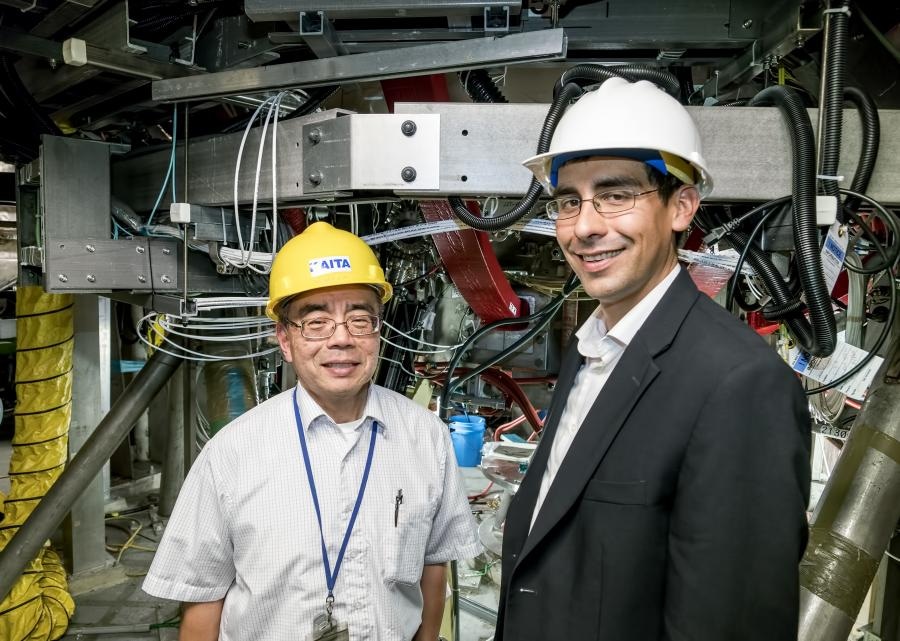May 22 2017
A team of physicists at the U.S. Department of Energy’s (DOE) Princeton Plasma Physics Laboratory (PPPL) have discovered that lithium compounds enhance plasma performance in fusion devices in the same manner as that performed by pure lithium.
 PPPL physicists Robert Kaita and Michael Jaworski in front of the National Spherical Torus Experiment-Upgrade Photo by Elle Starkman
PPPL physicists Robert Kaita and Michael Jaworski in front of the National Spherical Torus Experiment-Upgrade Photo by Elle Starkman
Matt Lucia, former Princeton University physics graduate student, conducted the research under the guidance of Robert Kaita, principal research physicist at PPPL and one of Lucia’s thesis advisors, as well as the team of scientists working on a machine called the Lithium Tokamak Experiment (LTX). Lucia, as part of his dissertation, analyzed how lithium deposited on walls of doughnut-shaped fusion machines called tokamaks affected the performance of LTX. The plasma within LTX, just like the plasma within a tokamak, is doughnut-shaped. The plasma, referring to a soup of charged particles, is surrounded by a copper shell with an inner stainless steel wall.
The Materials Analysis and Particle Probe (MAPP), a new device invented at the University of Illinois at Urbana-Champaign and installed on LTX, was used by Lucia. This new device allows scientists to withdraw samples into a chamber linked to LTX and analyze them without compromising LTX’s vacuum environment. With MAPP, scientists can now analyze how tokamak plasmas affect a material instantly after the experiment ends. In the past, scientists were only able to study samples only after the machine shuts down for maintenance. At this point, the vacuum was broken and the samples were exposed to a number of experiments, and also to air.
Lucia coated a piece of metal with lithium by using the evaporation technique, and then the metal was exposed to plasma within LTX by using the MAPP. As anticipated, Lucia spotted lithium oxide, which develops when lithium reacts with residual oxygen in LTX’s vacuum chamber. However, he was surprised to learn that the compound was almost as capable of absorbing deuterium just like pure lithium.
“Matt discovered that even after the lithium coating was allowed to sit on the plasma-facing components within LTX and oxidize, it still was able to bind hydrogen,” said Kaita.
“For a while, we were thinking you had to have high-purity lithium because we thought that if the lithium already has a dance partner — oxygen — it’s not going to dance with hydrogen,” said Mike Jaworski, research physicist at PPPL and co-author of the paper. “We thought that once it was oxidized, lithium would be chemically inert. But in fact we found that lithium will take all the dance partners it can get.”
The results obtained by Lucia are considered to be the first direct evidence that lithium oxide develops on tokamak walls and that it holds back hydrogen isotopes just as pure lithium. These results support the observation that lithium oxide is capable of forming on both metal, and on graphite, like the tiles in NSTX, and enhancing plasma performance.
The results support past findings related to PPPL’s National Spherical Torus Experiment (NSTX), a tokamak. A large metal ring coated with lithium was placed on the floor of NSTX’s vacuum vessel by scientists in 2010. This device, called the Liquid Lithium Divertor (LLD), was the initial attempt to develop a large lithium-coated metal surface inside NSTX. Scientists later studied the divertor’s surface after the NSTX divertor was exposed to residual oxygen in the vacuum vessel. The divertor was heated by the team and deuterium was detected. The finding pointed out that the deuterium had been trapped by the lithium oxide in the LLD, however the evidence was not definitive.
These latest findings highlight that it is not necessary for lithium within tokamaks to be as pure as once thought. The findings also highlight that if the carbon tiles in NSTX, now the National Spherical Torus Experiment-Upgrade (NSTX-U), are replaced with metal tiles and then coated with lithium, the performance of the plasma should not decline. “The key thing is that we can keep on using lithium evaporation if we go to metal walls in NSTX-U,” Kaita said.
More research will have to be carried out by the team in order to determine whether these findings will be relevant to future plasma machines, which could have flowing liquid metal walls capable of containing both lithium oxide and lithium. “If we want to extrapolate our results to a fusion reactor, we have to ask whether the experiments are indicative of the performance we could expect in the future,” said Jaworski. As the next step, this research will focus on accurately measuring the hydrogen retention rate of both oxidized and pure lithium, followed by comparing them rigorously.
The findings were published in the April 2017 issue of Fusion Engineering and Design. The DOE Office of Science (Fusion Energy Sciences) funded the research.
The team was made up of scientists from PPPL, the University of Illinois at Urbana-Champaign, The College of New Jersey, Princeton University, and Lawrence Livermore National Laboratory.